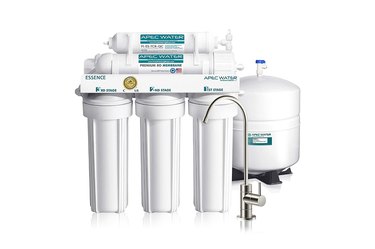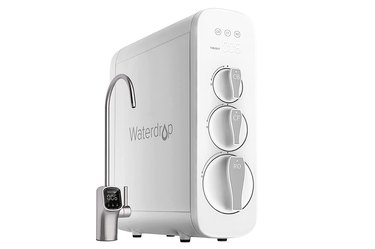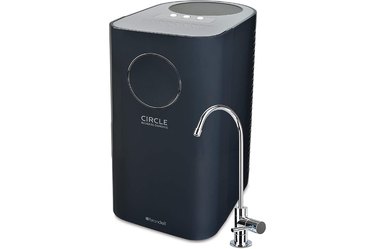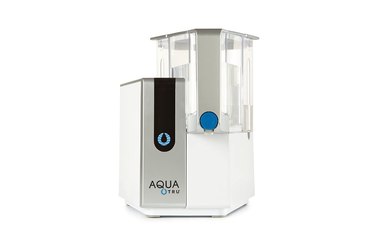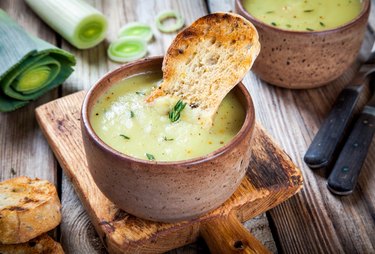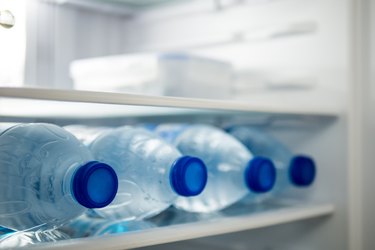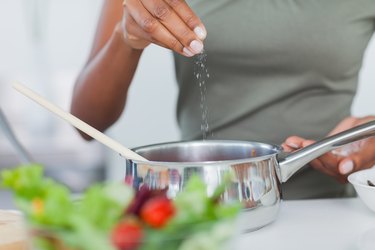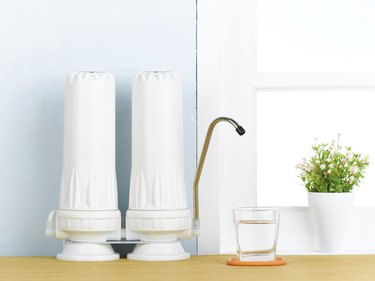
You may not be able to taste it, but it's possible there is sodium in your drinking water.
"Most people don't consider water when it comes to sodium," says New York City-based dietitian Amy Shapiro, RD, founder and director of the private practice Real Nutrition.
Video of the Day
Video of the Day
"While the small amounts of sodium in water isn't typically a concern for the general population, it may be more important for certain health conditions," says Mackenzie Burgess, RDN, registered dietitian and recipe developer at Cheerful Choices.
For instance, people with high blood pressure (which includes nearly half of all adults in the United States, per the Centers for Disease Control and Prevention), as well as those with heart disease, people with kidney problems and those who are on a low-sodium diet may have cause to want to limit drinking water that contains sodium, Shapiro says.
"You also would have to be concerned about drinking water and the water you use for cooking beyond your usual concerns of the amount of sodium found in your foods," she says.
Installing a water filter to remove sodium may help you cut back on your salt intake. But not just any filter will remove this mineral — here are the best ones, along with what you need to know about why your water might contain sodium and how to remove it.
The Best Water Filters That Remove Sodium
- Best Budget-Friendly: APEC Water Systems ROES-50 Essence Series Top Tier 5-Stage Certified Reverse Osmosis Drinking Water Filter System ($179.95, Amazon)
- Best Tankless: Waterdrop G3 Reverse Osmosis System ($499, Amazon)
- Best Under the Sink: Brondell H2O+ Circle Reverse Osmosis Water Filtration System ($375, Amazon)
- Best Countertop: AquaTru Countertop Water Filtration Purification System with Exclusive 4-Stage Ultra Reverse Osmosis Technology ($449, Amazon)
How We Chose
When it comes to removing sodium from your water, the best tactic is typically reverse osmosis (RO).
"A water filtration system that uses a physical filtration method is often recommended [when you want to remove sodium from your water], such as reverse osmosis, which actually removes those minute particles," says Riggs Eckelberry, water expert and founder and CEO of OriginClear, a Clean Water Innovation Hub.
Here's why a reverse osmosis filter is more meaningful than just a filter alone: A reverse osmosis filter has multiple layers, as well as a semi-permeable membrane, explains Timothy Dunphy, a water expert at Leaf Home Water Solutions. Pressure sends water through this membrane, per the NSF.
"Because of the pressure, it just lets a portion of the water through," Dunphy says. The water is then split into two streams: wastewater and purified water that's stored in a tank, Dunphy says. The membrane provides a ton of filtration, so that it rejects sodium as well as other minerals and contaminants.
As well as looking for water filters that incorporated reverse osmosis, we sought out options from reputable brands with strong reviews and looked for systems with third-party certification.
1. Best Budget-Friendly: APEC Water Systems ROES-50 Essence Series 5-Stage Certified Reverse Osmosis Drinking Water Filter System
Pros
- Budget-friendly
- Long-lasting filters
Cons
- Tank is only 4 gallons
- Installation required
Cost can be a prohibitive factor with RO systems. Many are quite pricey, and may potentially require that you hire someone for installation help. This budget-friendly option is made in the U.S. It's also certified by the Water Quality Association (WQA).
It comes with a faucet and food-grade tubing and offers a warranty. Filters last 6 months to a year — many other systems have more short-lived filters. These filters are, of course, essential to the system working, and their cost can add up.
This under-the-sink system has a 4-gallon tank and can produce up to 50 gallons of water per day, per the manufacturer. For heavy water users or large families, that may not be enough. For every 1 gallon of filtered water, there are 3 gallons of wastewater.
Buy it: Amazon.com ($179.95); HomeDepot.com ($199); Apec Water ($199.95)
2. Best Tankless: Waterdrop G3 Reverse Osmosis System
Pros
- NSF-Certified
- Offers smart display
- Speedy
- Space-saving option
- Low wastewater
Cons
- A pricier option
- Requires power source nearby
Short on space underneath your sink? This tankless NSF-certified RO system might be the right option for you. It'll free up to 70 percent of space underneath your sink, per the manufacturer (leaving room for cleansers, buckets and the other household items that previously occupied the space).
Note that this system contains a carbon block that's made from coconut shells — so, if you have a coconut allergy or intolerance, this system is best avoided.
The Waterdrop reverse osmosis system also comes with a faucet that has a smart display, so you can see useful information like the quality of your water, the total dissolved solids (TDS) and when the filter needs to be replaced.
With this RO system, you'll get a 1:1 wastewater-to-clean-water ratio — that adds up to less waste (and potentially lower water bills) than many other systems. Plus, it offers up to 400 gallons of water a day.
Note that the unit needs to be plugged in, a potential inconvenience if you do not have a plug readily available where the system goes. An accessory kit is required to connect the unit to your refrigerator.
Buy it: Amazon.com ($499)
3. Best Under the Sink: Brondell H2O+ Circle Reverse Osmosis Water Filtration System
Pros
- Easy to install
- Highly efficient
Cons
- Takes up a lot of space under the cabinet
- Small-ish storage tank
- Replacement filters may be costly
This RO water filter is certified by the WQA and also meets NSF standards. It sits under the sink and comes with a chrome kitchen faucet that shows when filters need to be replaced.
The tank fits 6 liters and fills in less than an hour. Installation is relatively simple — it doesn't require any plumbing.
Buy it: Amazon.com ($375); Walmart.com ($449.99); Brondell.com ($449.99)
4. Best Countertop: AquaTru Countertop Water Filtration Purification System with Exclusive 4-Stage Ultra Reverse Osmosis Technology
Pros
- No installation required
- Long-lasting filters
Cons
- Pricier option
- Low water capacity
Renters, those who shudder at the thought of DIY home projects or anyone with limited space underneath their sink may gravitate toward a countertop reverse osmosis system.
This RO system meets NSF/ANSI standards and does not require installation or plumbing know-how to get started. Instead, just find a spot on your counter that's near a power source and plug it in.
This unit has a 1-gallon capacity, but only holds 3 quarts of purified water. That may make it less than ideal for cooking needs. The filters last for 6 months to 2 years (or, between 600 and 1,200 gallons of water). There's an alert when the filters need to be replaced.
The system works fast, generating purified water in just minutes.
Buy it: Amazon.com ($449); Lowes.com ($449); AquaTruWater.com ($359)
Why Might You Have Sodium in Your Water, Anyway?
There are a few reasons why your water may contain sodium. First, it does naturally occur in groundwater, Eckelberry says. Living by the ocean can also lead to an increase in salinity, Dunphy notes. Contaminants (think: road salt, fertilizer and sewage) can also be a factor.
"There is no drinking water standard for sodium but for those who are on a very low sodium diet they should have no more than 20 mg/liter," Shapiro says. Sodium concentrations in drinking water should be between 30 and 60 mg/L, per the Environmental Protection Agency (EPA) but note that this is just a guideline given because of taste, and not enforceable, per the EPA.
There's another big reason sodium may be present in your water: Water softeners.
"If you have a softening system, that softening system is also going to potentially put some additional sodium into your water," Dunphy says. A softening system is used to transform hard water into soft water.
While hard water is generally seen as undesirable, it doesn't innately present health hazards. Rather, hard water — which contains dissolved elements including calcium and magnesium — makes it hard for soap to lather, creates scaling in pipes and generally "cause[s] numerous problems in laundry, kitchen and bath," per the WQA.
How to Know if Your Water Contains Salt
Sometimes you can actually taste the sodium, Shapiro says. But if it could be present in low levels, and not detectible by your taste buds.
One simple step to determine your water's sodium levels: Check with your water providers, Eckelberry recommends. Water treatment plants and public water suppliers are required to make this information publicly available, Dunphy says.
You can also enter your ZIP code in the Environmental Working Group's tap water database, Dunphy says.
Water test kits can be used, Eckelberry says. These can be used if you have private well water; you can find them easily online (Well Water Test Kit for Drinking Water, $35.99). These tests are recommended every 3 to 5 years, Shapiro says.
Other Ways to Remove Sodium From Your Water
Other tactics can be used to remove sodium from your water. That does not include boiling water, which in fact, will increase sodium levels, per Simcoe Muskoka District Health Unit. Nor will using a Brita filter or similar filters do the trick to remove sodium.
Another effective option is distillation, per the Connecticut Department of Public Health. This process involves heating the water and collecting the condensed steam, which is free from minerals, according to Cooperative Extension.
You can also treat the water throughout your home with a whole-home filtration system, Dunphy says. That way, you won't have to wonder about the sodium levels in say, the ice that your refrigerator makes automatically. You can also potentially offload some of the required maintenance efforts, not to mention the installation, he says.
Your best solution may involve using two types of water treatment systems. If hard water is an issue, install a water softener, but only for hot water rather than for cold water so that your cooking and drinking water are unaffected. Or, install a secondary water treatment system to remove sodium and any other contaminants of concern. Your home improvement center or plumbing professional can provide further information regarding an appropriate set-up for your home.
What to Look for in a Water Filtration System
Here are some key considerations when it comes to purchasing a reverse osmosis system:
Price
As well as the cost of the reverse osmosis system, consider any installation costs that may be required and the lifespan of filters as you'll need to make sure that you're replacing those as needed.
Water Output and Tank Size
Take a look at the water production of the unit as well, and consider how much water you'll need on a daily basis. Check the water output per day, which is in gallons.
As well, consider the size of the tank: This is how much water is stored for your use. If you use a lot of water, you might use it faster than it's available. But a large tank, which offers more water-on-demand, might take up more space than is reasonable.
Measure your space before purchase, so you can confirm you have enough room for the tank. And, check for any other installation requirements — for instance, one option on this list requires a power source.
Wastewater Levels
Along with being hard on the environment, creating a lot of wastewater through reverse osmosis can lead to a higher water bill.
How to Limit Your Salt Intake
If you live in the United States, your salt intake is likely higher than it should be.
"As a dietitian, I recommend 2,300 milligrams of sodium per day and less for those on restricted-sodium diets but most people get more than 3,000 milligrams per day mainly from food sources," Shapiro says.
Water isn't a main culprit for salt intake, and you likely don't need to be concerned about the sodium in your water unless you're on a low-sodium diet or have certain conditions. That said, nearly all of us would be wise to reduce our salt intake — here are some salt-cutting tactics:
- Cut down on packaged and prepared foods. That's the real issue, not your salt shaker. About 70 percent of dietary sodium intake is through eating prepared/packaged foods, per the FDA.
- Check the label. When you purchase foods, look at the nutrition facts, and assess how much salt is in products. The goal is 2,300 milligrams a day or under. Then, opt for lower-sodium varieties of packaged goods. That may mean opting for low-sodium soup or unsalted nuts.
- Rinse canned products. This includes beans and canned veggies, which often contain added salt, per the FDA.
- Ask for less salt. If you're dining out, try requesting that salt not be added to your meal or choosing low-sodium options on the menu, per the U.S. Department of Health and Human Services.
- Centers for Disease Control and Prevention: "Facts About Hypertension"
- NSF: "Learn How Reverse Osmosis Works Straight From the Experts"
- Environmental Protection Agency: "Drinking Water Advisory: Consumer Acceptability Advice and Health Effects Analysis on Sodium"
- WQA: "Scale Deposits"
- Environmental Working Group: "EWG's Tap Water Database"
- Centers for Disease Control and Prevention: "About Sodium"
- FDA: "Sodium in Your Diet"
- U.S. Department of Health and Human Services: "Eat Less Sodium: Quick Tips"
- Simcoe Muskoka District Health Unit: "SODIUM IN DRINKING WATER"
- Connecticut Department of Public Health: "Sodium & Chloride in Well Water"
- Cooperative Extension: "Drinking Water Treatment – Distillation"
- National Sanitation Foundation: Home Water Treatment Devices
- MayoClinic.com: Water softeners: How Much Sodium Do They Add?
